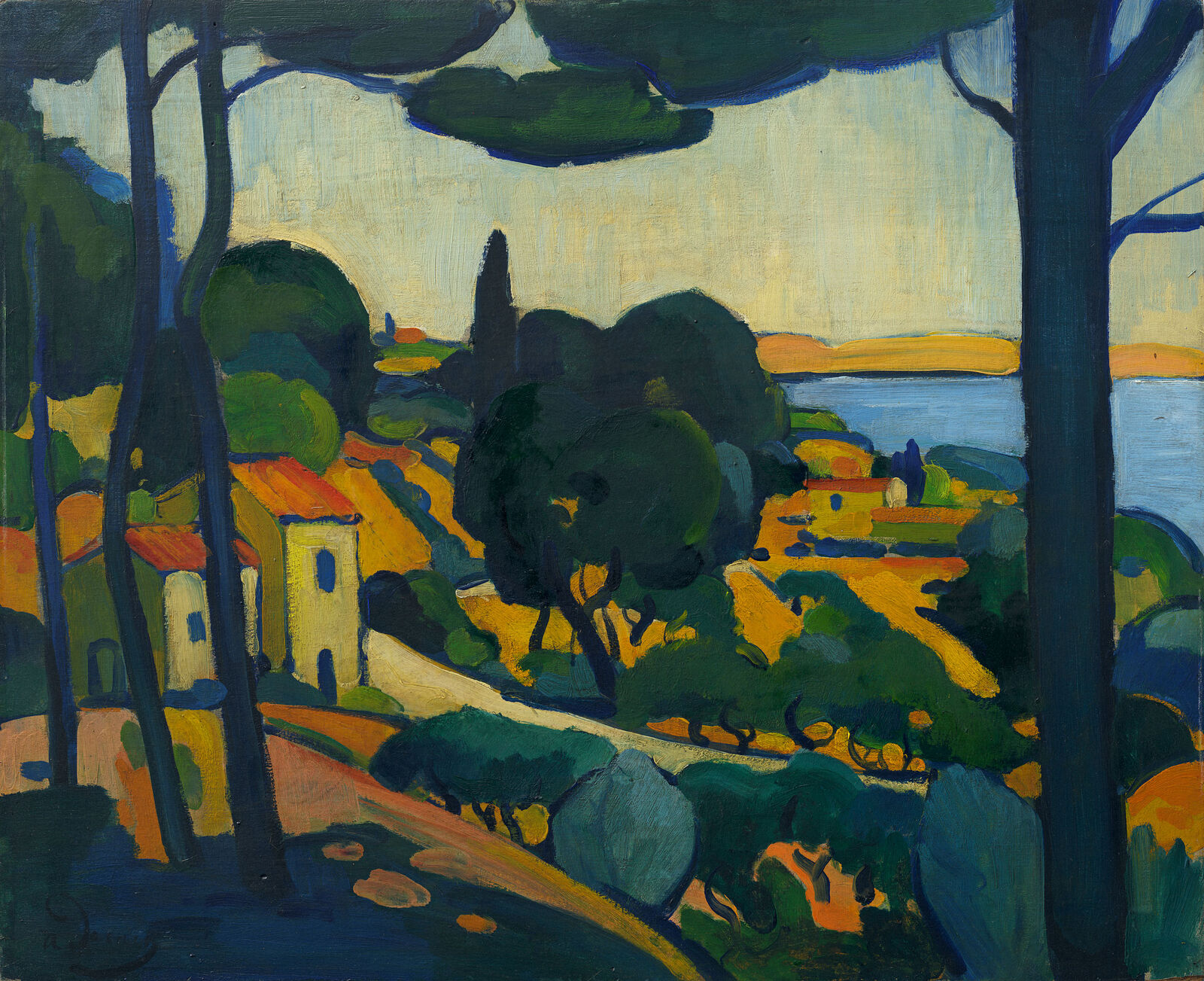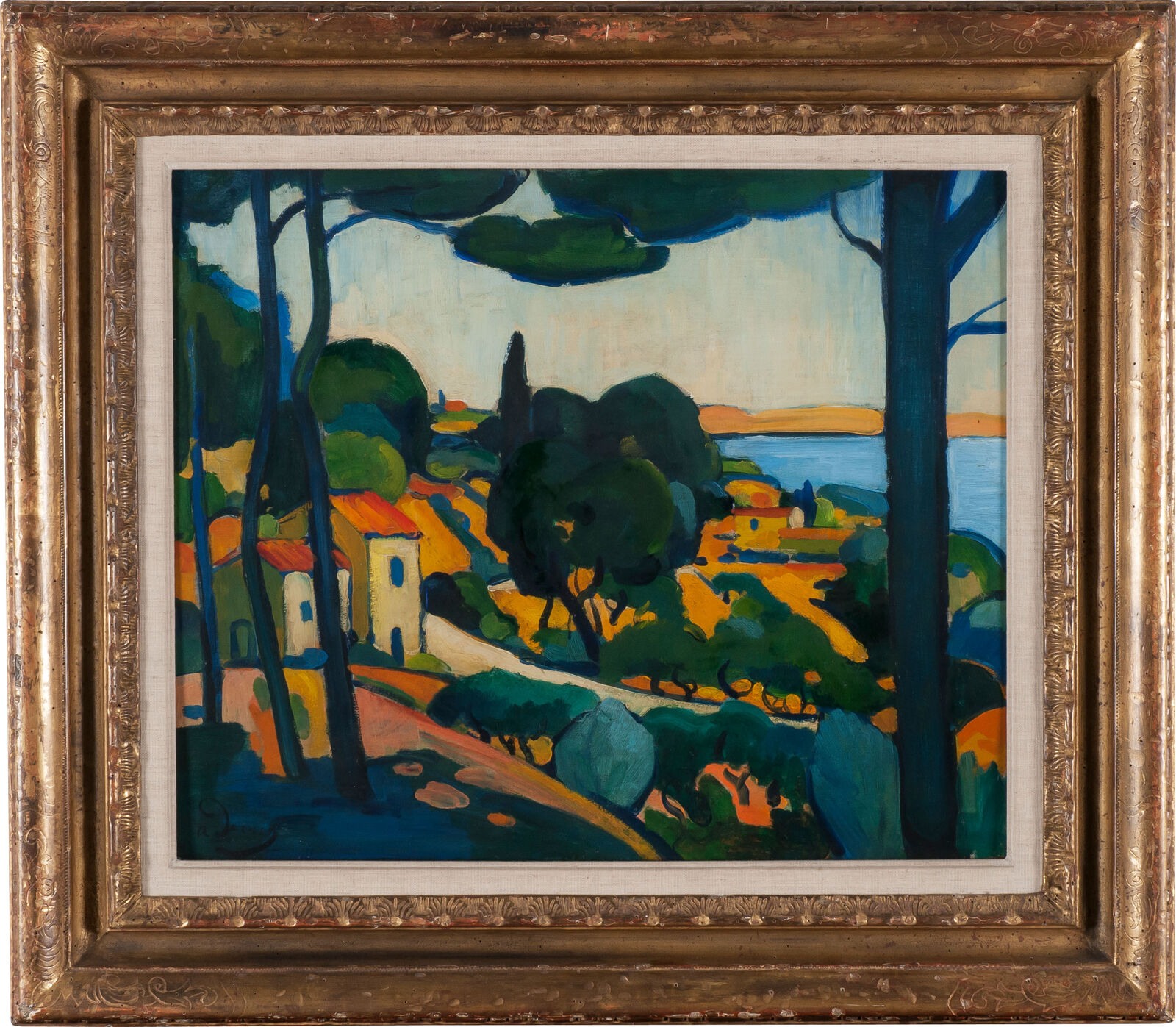André Derain
Landscape near Cassis, 1907/08
Not on view
Copy link
Oil on panel, 44,5 x 55 cm
Signed lower left: a. Derain
Inv.-no. MB-Der-01
When he painted Cassis in 1907, André Derain was exploring a locale that had already been painted by his older colleague Paul Signac. While the Pointillist had concentrated on the bay and the sea, Derain showed the periphery of the town and bordered it with Signac’s motif of the red cliffs and the bay with pine trees. Derain increased the contrast by means of the black-blue and black-green surfaces of the trees. Their trunks simultaneously frame and fragment the scene, and the eye of the beholder jumps back and forth between the dark and light areas of the composition.
André Derain is considered one of the most important painters of Fauvism, a short-lived movement that emerged in France around 1903–04 and lasted until about 1910. In 1898–99, Derain studied with the painter Eugène Carrière at the Académie Camillo in Paris, where he made the acquaintance of Henri Matisse. Following in the footsteps of such Neo-Impressionist painters as Paul Signac and Henri-Edmond Cross, the two artists spent a number of weeks in the French Riviera during the summer of 1905. In Collioure, under the influence of the southern light, they painted landscapes in brilliant, pure colors and expanded the Pointillist visual language to include flat, heavily contoured elements. The same year, the artists were represented at the Salon d’Automne in Paris with ten and nine works respectively, which were shown in the seventh exhibition room alongside works by artists including Albert Camoin and Maurice de Vlaminck. This newfangled way of painting, with its garish colors, caused a scandal: in a review from October 17, the influential critic Louis Vauxcelles compared the artists to “wild beasts” (fauves), from which the name of the movement was later derived.
Derain’s works of 1905–06 still include echoes of Pointillism, though the artist soon distanced himself from that movement’s characteristic dissection of the picture plane and embraced clearly contoured, rhythmically interconnected areas of color. Like other Fauve painters, his intent was not to transcribe a momentary impression, but to expressively transform nature through his own power of imagination. Accordingly, Derain liberated color from its descriptive function and employed it freely in service of the internal, ornamental logic of the image—a radical step in the direction of abstraction.
In the summer of 1907, Derain spent a number of weeks in the port city of Cassis in the south of France. The paintings he made there show the influence of Paul Cézanne in their use of interlocking geometric elements and a striking tendency toward flatness. Landscape near Cassis shows a pictorial formula reminiscent of Cézanne’s compositions from the south of France such as L’Estaque, View through the Trees (1879, private collection). Here, too, Cézanne showed a townscape framed by the arabesques of tree trunks, sloping down toward the sea, and exploited the contrast between dark vegetation and brightly glowing architecture in a decorative manner. New for Derain, however, is the exaggeration of the linear effect and the intensity with which he flattens the individual elements of the picture—an approach that seems to anticipate the schematic visual world of Analytic Cubism as later developed by Pablo Picasso and Georges Braque.
Daniel Zamani
Modern Art Classics: Liebermann, Munch, Nolde, Kandinsky, Museum Barberini, Potsdam, January 23–May 28, 2017
Impressionism: The Hasso Plattner Collection, Museum Barberini, Potsdam, from September 5, 2020
La Grande Bleue: Schilders van de Méditerranée, Singer Laren, September 12, 2023–January 7, 2024
n.d., Private
collection, Belfort
n.d., Private
collection, Grenoble
n.d.,
Sir Robert Barlow, Wendover, Buckinghamshire
n.d.,
Walter Goetz, Paris
n.d.,
Galerie Les Tourettes, Basel
1971, Private
collection, Switzerland
March
2007, purchased from a private collection
Pierre Cabanne, André Derain, Paris 1990, 142, ill. 47.
Michel Kellermann, André Derain: Catalogue raisonné de l'œuvre peint, vol. 1, Paris 1992, no. 144, ill. 90.
Ortrud Westheider, Impressionism. The Hasso Plattner Collection, coll. cat., Museum Barberini, Potsdam 2020, 250, 265, ill. 242.
La Grande Bleue: Schilders van de Méditerranée, exh. cat., Singer Laren, Laren 2023, ill. 18, 52.
Barberini Audioguides
Do you have suggestions or questions?
sammlung@museum-barberini.de.

